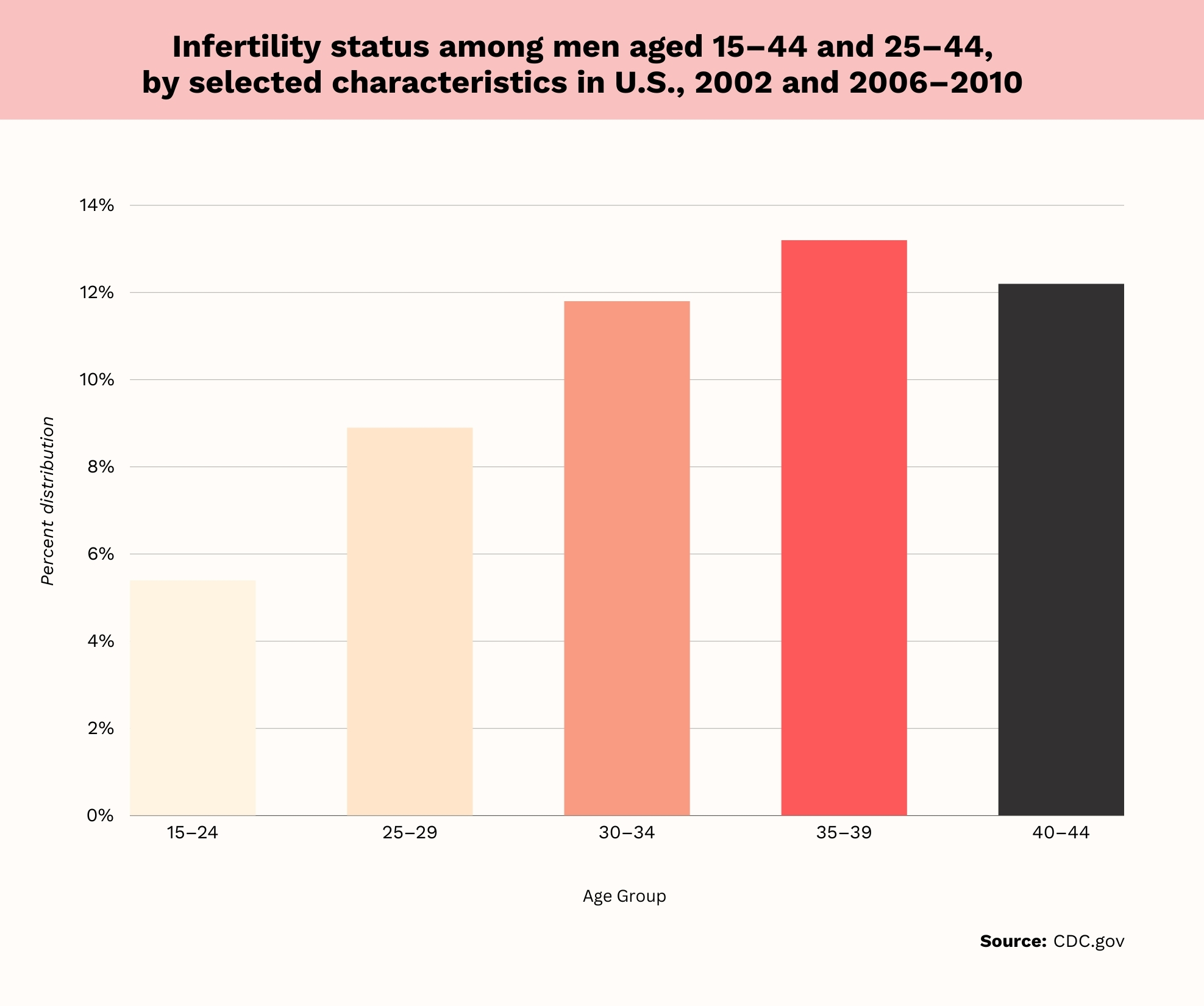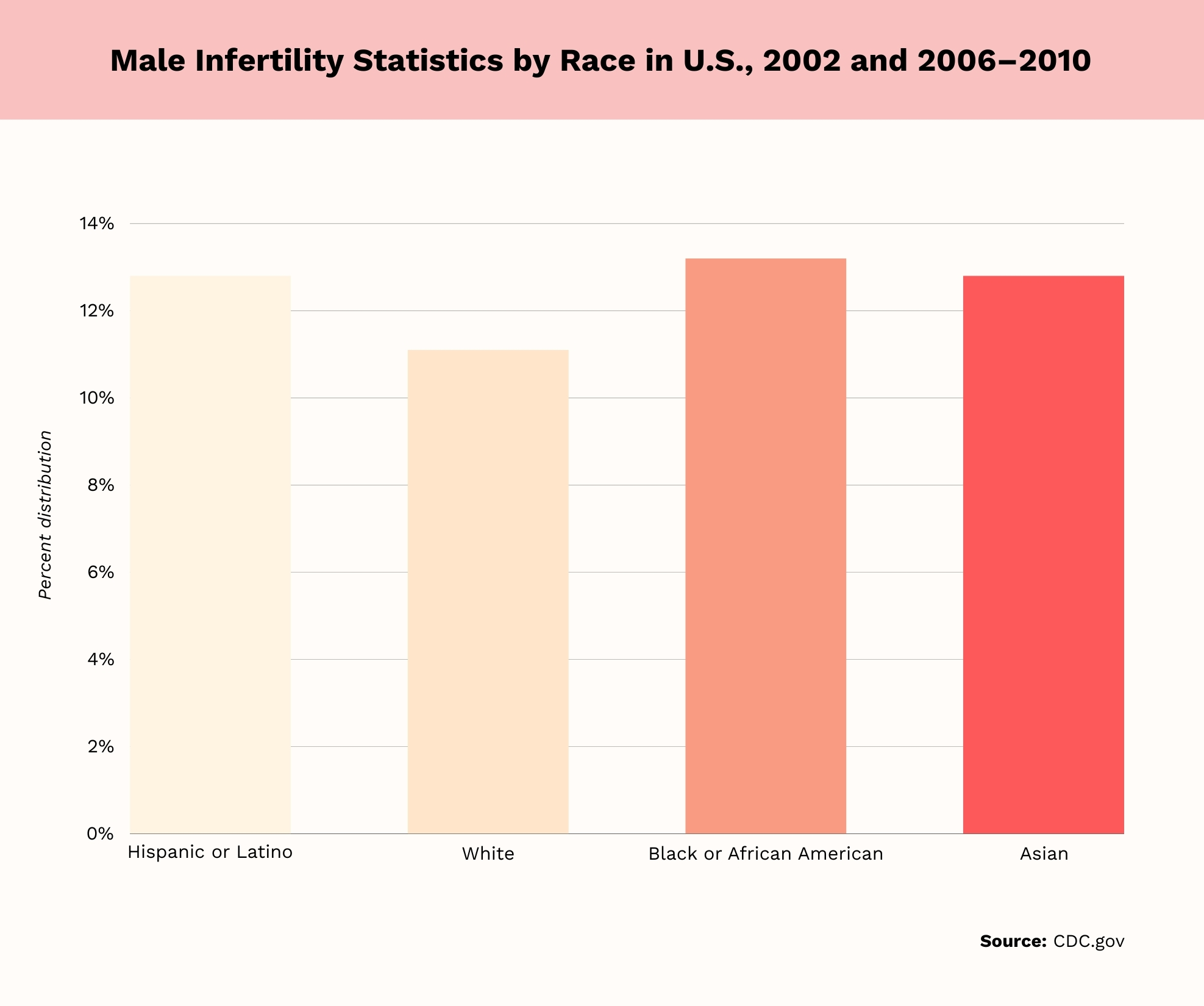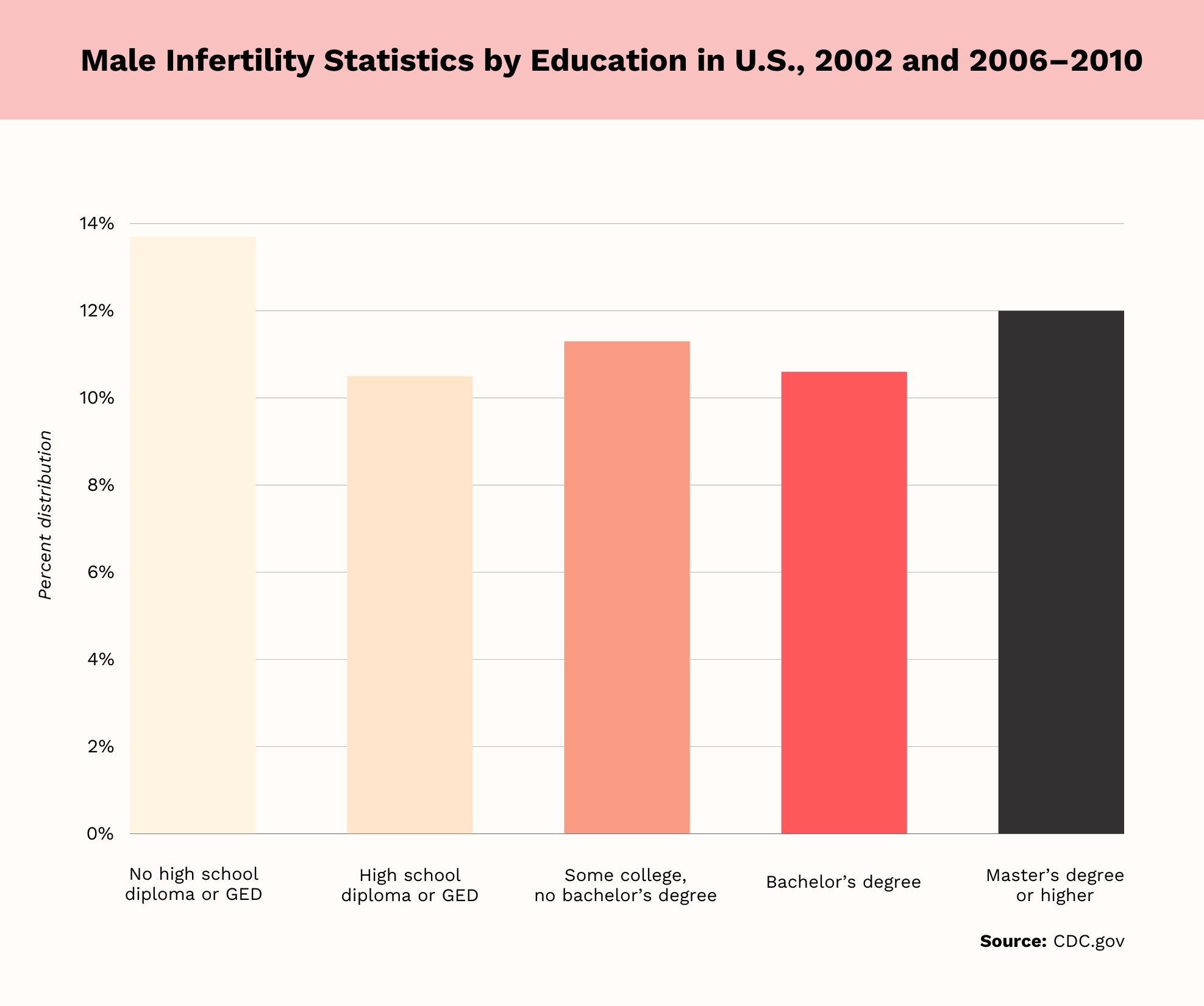Infertility is defined as being unable to conceive after a year or more of having unprotected sex. Sometimes, infertility issues arise because of a medical problem with the woman in the partnership. In other cases, the problem is with both partners or with the man alone.
Hormones and other factors can contribute to infertility in men. Below, learn the top male infertility statistics. You’ll find information about the prevalence of infertility in men, as well as the causes of this problem.
Key Facts About Male Infertility In The USA
In the U.S., around 9%[1] of men of reproductive age experience infertility.
In one-third[1] of couples experiencing infertility, the man alone has the fertility problem.
After one year of unprotected sex, 12%-15%[1] of couples are unable to conceive.
After two years of unprotected sex, 10%[1] of couples have not been able to have a baby.
Key Male Infertility Facts
- In the U.S., around 9%[1] of men of reproductive age experience infertility.
- In one-third[1] of couples experiencing infertility, the man alone has the fertility problem.
- The problem is with the women in one-third[1] of couples experiencing infertility.
- The problem is unidentified or is with both the man and women in one-third[1] of couples experiencing infertility.
- After one year of unprotected sex, 12%-15%[1] of couples are unable to conceive.
Male Infertility Statistics In The United States
Male Infertility Statistics By Age

-Among men aged 15-24, 5.4%[2] are infertile.
-In those aged 25-29, 8.9%[2] are infertile.
-The infertility rate among men aged 30-34 is 11.8%.[2]
-Among men aged 35-39, 13.2%[2] are infertile.
-Finally, 12.2%[2] of men aged 40-44 are infertile.
These data are from 2006-2010, which are the most recent comprehensive data in the United States. In men, the infertility rates above are based on the percentage of men who are either non-surgically sterile or subfertile.
Men who are non-surgically sterile[2] report they are physically unable to have children. They have not had a procedure like a vasectomy that would lead to sterility. Subfertile[2] men are physically able to have children but have had difficulty doing so.
As indicated above, the rate of infertility in men generally increases with age.[2] Those aged 15-24 have the lowest percentage of infertility cases. The highest rate of infertility in men is among those aged 35-39.[2]
According to infertility expert Dr. Nandita Palshetkar, MBBS, MD – Obstetrics & Gynaecology, “Observations in clinical settings suggest a rise in male infertility cases or men seeking help for infertility.”
Male Infertility Statistics By Race

-Among Hispanic/Latino men, the infertility rate is 12.8%.[2]
-Among White men, 11.1%[2] are infertile.
-In Black or African American men, the infertility rate is 13.2%.[2]
-The infertility rate is 12.8%[2] in Asian men.
Rates of male infertility vary somewhat by race. White men have the lowest infertility rate, whereas Black men have the highest rate. Nonetheless, the difference in prevalence of infertility between Black and White men is just 2.1%.[2]
Male Infertility Statistics By Education

-In men with no high school diploma or GED, the infertility rate is 13.7%.[2]
-Among men with a high school diploma or GED, 10.5%[2] are infertile.
-The infertility rate is 11.3%[2] in men with some college but no bachelor’s degree.
-Among men with a bachelor’s degree, 10.6%[2] are infertile.
-For men with a master’s degree or higher, the infertility rate is 12.0%.[2]
Men who have not graduated high school or obtained a GED have the highest infertility rate, at 13.7%.[2] The lowest rate is in those with a high school diploma or GED, at 10.5%.[2] Men with a bachelor’s degree have the second lowest infertility rate, at 10.6%.[2]
Male Infertility Facts To Know
There is additional infertility in men statistics beyond general prevalence. Below, learn some additional facts about male factor infertility.
Treatment-Seeking Varies By Race
Whether a man seeks infertility treatment varies based on his race. In one study of men seeking infertility treatment, 51%[3] were White.
An additional 20%[3] were Asian/Indo-Canadian or Indo-American. Finally, 6%[3] were Black, 1%[3] were Native American/American Indian, and under 1%[3] were Native Hawaiian or Pacific Islander.
The majority of men who seek infertility treatment are White. Furthermore, White men seek evaluation sooner when compared to men of other races. On average, they wait 3.5[3] years before seeking infertility treatment.
On the other hand, Black men wait 4.8[3] years, on average, to seek treatment. American Indian/Native American men sought infertility treatment after an average of 5.1[3] years.
Several Factors Tend To Precede Male Infertility Evaluation
Before seeking evaluation and treatment for male infertility, couples may try other treatment options. There are also specific medications that may precede male infertility.
In one study, 12.1%[4] of couples attempted intrauterine insemination prior to seeking male infertility treatment. Furthermore, 4.9%[4] had undergone up to six cycles of in vitro fertilization. Of men seeking infertility services, 0.9%[4] had previously used the medication finasteride, and 1.6%[4] had used testosterone.
Demographic Trends In Male Infertility Reflect Trends Seen In Women
Male fertility statistics show that Black men have the highest infertility rates, at 13.2%.[2] White men have the lowest rates, at 11.1%.[2] The rate in Hispanic men is 12.8%.[2]
Similar trends are seen in women. White women have lower infertility rates than Black women, at 5.5%[2] for White women compared to 7.2%[2] for Black women. Hispanic women have an infertility rate of 6.1%.[2]
We see racial variation in female infertility, much like with men. Black women have the highest infertility rates, similarly to Black men.
How Is Male Infertility Diagnosed?
Male factor infertility is diagnosed through a physical examination and specialized blood tests. A doctor will gather information about the patient’s reproductive history and conduct a semen analysis to determine sperm concentration.[5] For the most accurate results, semen analysis should occur with multiple ejaculation parameters.
If semen analysis or reproductive history is abnormal, a patient should be referred to a urologist or similar specialist. This professional can conduct further evaluation.
Men with severe male factor infertility are likely to have genetic abnormalities[5] that contribute to the problem. When a man has an extremely low sperm count, especially at an early age, genetic testing may be warranted as part of diagnosis and treatment.
Symptoms Of Male Infertility
The most obvious symptom of male factor infertility is the inability of a couple to conceive[6] after a year of unprotected sex. While the female partner may also be to blame, male factors should also be considered.
Aside from lack of conception after a year of unprotected sex, other signs and symptoms associated with male infertility[6] include:
- Reduced sperm concentration or motility.
- Genital tract infections.
- Hormonal problems.
- Sexual dysfunction, such as erectile dysfunction.[7]
- History of trauma to the testicles.[7]
- Having an undescended testicle.
- Diagnosis of[8] cystic fibrosis.
What Causes Male Infertility?
In many cases, infertile men have problems related to semen quality or sperm morphology. One study found the leading cause of male factor infertility was asthenozoospermia,[6] which occurs when sperm motility is reduced. This means the sperm are not able to move as easily as they should to fertilize an egg.
Infertile males may also have low sperm counts. In some cases, infertility is caused by a condition called azoospermia,[9] when there is no sperm in the ejaculate.
Sperm can also become hyperviscous,[10] leading to low sperm quality and infertility. Hyperviscous sperm may result from oxidative stress and a depletion of vital antioxidants in the diet.
There are several causes of low sperm counts and poor sperm quality. These include hormonal and genetic problems,[7] an inadequate diet, as well as testicular and ejaculatory dysfunction.
According to Dr. Sumeet Kumar, Ph.D. in Genetics and Founder of GenesWellness, “Male infertility is often linked to a mix of genetic issues, health conditions, and the way we live our lives.” He further states, “At the heart of many fertility problems are genetic factors. This means that issues with our genes can lead to problems with sperm quality and the ability to father children.”
Dr. Kumar adds, “Hormonal imbalances, which can be influenced by our genes, play a big part in sperm production.” He additionally states, “Even physical issues, like blockages or swollen veins in the scrotum, known as varicoceles, can be related to genetic backgrounds.
How To Prevent Male Infertility
There are several risk factors for reproductive health issues, including male factor infertility. In order to prevent this problem, it’s important to address and modify your risk factors using reproductive medicine for guidance.
The various risk factors for male partner infertility, as well as ways to prevent them, are discussed below. Many of these risk factors include modifiable lifestyle factors.
Obesity
Being overweight or obese, and especially being morbidly obese, are harmful to reproductive health. Research suggests that obesity[5] can affect sperm morphology in male partners and lead to reduced sperm counts. Obesity is also linked to reduced ejaculate volume.
Given the link between obesity and sperm count, it’s important to maintain a healthy way to prevent infertility. Men dealing with infertility may benefit from weight loss interventions to reduce BMI. This can include following a reduced-calorie diet and implementing a regular exercise program.
Substance Abuse
Several studies have demonstrated that cigarette smoking[5] can damage semen quality. Smoking is also linked to reduced sperm count and concentration. Avoiding cigarette smoking and getting help to stop if you’re a smoker could prevent infertility.
Drug and alcohol abuse[11] can also alter sperm production and increase the risk of infertility. For example, abuse of alcohol, opioids, and anabolic steroids can reduce testosterone production. This, in turn, affects sperm production.
Poor Diet
Poor quiet quality can lead to lower sperm counts and poor male reproductive health. One study that included semen analyses found that Western dietary patterns[12] were linked to reduced sperm motility and sperm counts. This diet includes high amounts of sweets/snacks, processed and red meats, refined grains, dairy products, potatoes, and animal fats.
On the other hand, healthy diets[13] that are rich in fruits, vegetables, whole grains, nuts, poultry, and seafood can improve sperm quality. Antioxidant consumption[5] and supplementation can also be beneficial for reducing oxidative stress that negatively affects sperm parameters.
Environmental Factors
Finally, there is some evidence that environmental factors, such as exposure to radiation[7] or environmental toxins, harm fertility. Frequently exposing the testes to high temperatures can also be harmful.
If you’re trying to promote reproductive system health, it can be helpful to avoid toxic chemicals.
Treatment Of Male Infertility
Male patients can benefit from treatment to address the causes of male infertility. These treatments can help men and their partners to achieve pregnancy.
Treatment of male infertility typically involves using medical interventions that increase production of testosterone and follicle-stimulating hormone. This, in turn, promotes sperm production.
Some medications[14] that may be used to treat infertility in men include:
- Gonadotropin-releasing hormone, or GnRH, is available as a subcutaneous infusion from a fertility clinic.
- Gonadotropins, including human chorionic gonadotropin, are self-administered as a subcutaneous injection.
- Dopamine agonists like bromocriptine or cabergoline, used in men with high prolactin levels.
- Selective estrogen receptor modulators, like clomiphene citrate, used off-label to increase testosterone levels.
Medications can improve semen parameters, but sometimes, medication alone doesn’t help infertile couples achieve pregnancy. Assisted reproductive technology like intracytoplasmic sperm injection, ICSI, may be used in this case. This treatment[15] involves injecting a sperm cell into an egg during in-vitro fertilization.
The use of ICSI is becoming more popular, but it may come with risks. It can increase the risk[15] of chromosomal abnormalities, autism, intellectual disabilities, and congenital disabilities.
According to Dr. Palshetkar, “Depending on the underlying cause, treatments may include medication, surgery for varicocele, or hormone treatments.” She adds, “Techniques such as in vitro
fertilization or intracytoplasmic sperm injection are often employed when other interventions are not successful.”
Conclusion
Fertility problems are relatively common in men, affecting about 9%[1] of males. These problems result from issues with the sperm. This can include a lack of sperm or conditions in which sperm moves poorly, called poor sperm motility.
The good news is that lifestyle changes like following a nutritious diet and losing weight can improve sperm quality. In cases where changes in habits do not improve fertility, it’s important to see a doctor to get a physical examination. A doctor will take your medical history and find the root cause of infertility.
A fertility specialist can provide treatment for genetic abnormalities or endocrine disorders leading to fertility issues. They can also prescribe medications to improve semen quality and increase semen volume. If medication doesn’t work, assisted reproductive technologies are available.
Frequently Asked Questions
According to data from the U.S., about 9% of men experience infertility. These rates can vary based on age and race/ethnicity.
Research shows that the sperm count[16] declines with increasing age. With aging, there is a reduction in sperm production and total sperm count.
Infertility is typically defined as a couple being unable to conceive after a year or more of unprotected sex. The man may not be fertile if a partner cannot conceive after a year. You will need to seek medical evaluation to confirm fertility.
 Evidence Based
Evidence Based
